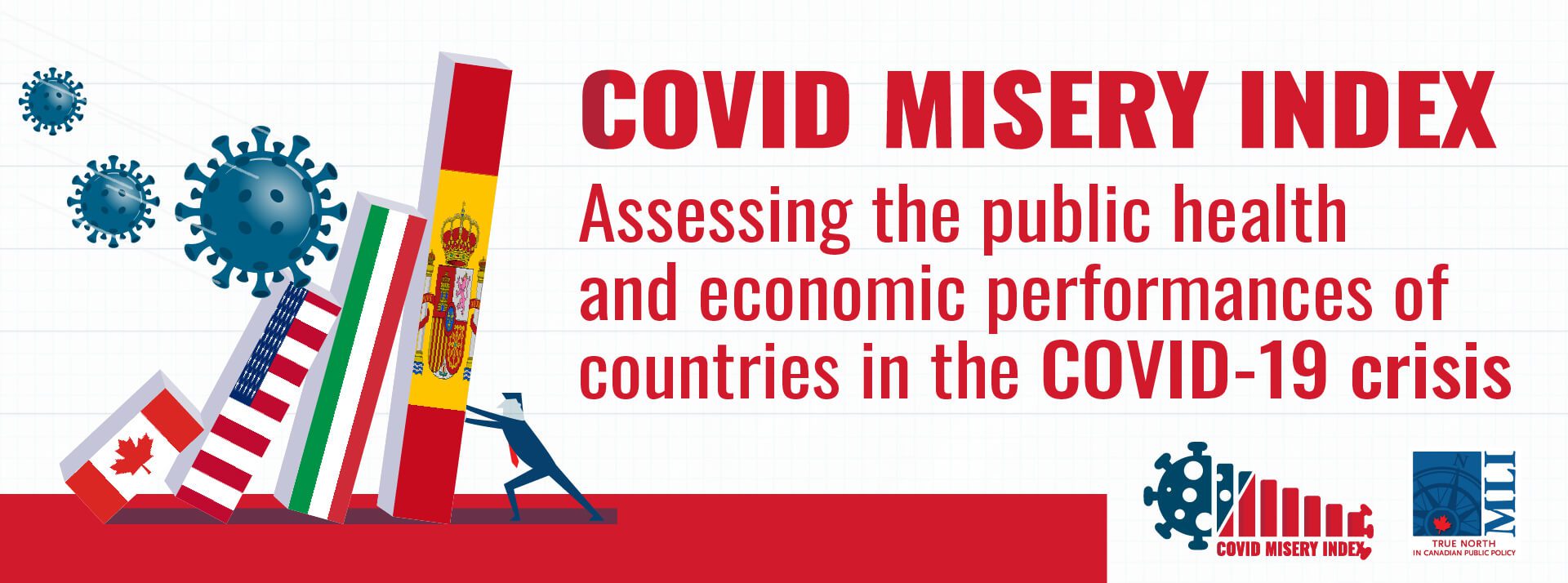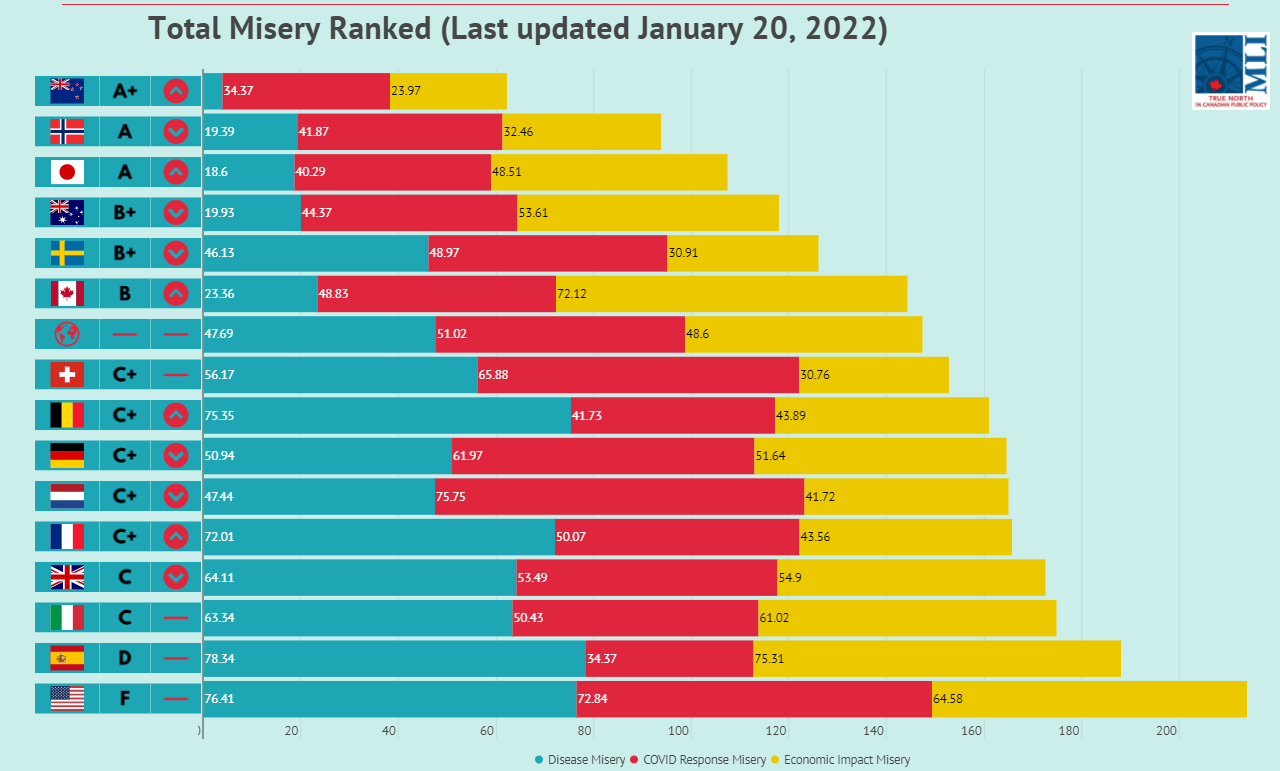View the full, updated COVID Misery Index (CMI) here. Download the data for the January 20, 2022 update here. For more information, including a full methodology and analysis of the initial CMI, click here, and view the original, non-updated CMI here.
To find all the MLI products related to the CMI, click here.
THE LATEST CMI
How quickly are we getting people vaccinated? How tough are the public health restrictions? How well is the economy recovering? MLI has the answers with the latest update of the COVID Misery Index.
MLI COVID Misery Index Update (January 20, 2022): The Macdonald-Laurier Institute’s COVID Misery Index is updated regularly as we follow the progress of 15 developed countries to preserve the health, well-being and prosperity of their citizens during the pandemic. There are three categories: Disease Misery, a measure of the impact of sickness and death from the disease, Response Misery, a ranking of how well governments are doing on measures such as the success of vaccine rollouts or having to rely on restrictive lockdown measures, and Economic Misery, which takes into account the impact on jobs, growth and government finances.
THE CMI IN THE OMICRON WAVE
The Omicron variant has given COVID-19 an opportunity to reassert itself upon the world. Caseloads are higher than at any point in the pandemic for a number of countries and ongoing case identification remains a challenge due to the limits of testing facilities. As a result, many countries have seen slowed or reversed re-openings, reduced health service provision, ongoing challenges at borders and a general disruption to people’s lives.
The Macdonald-Laurier Institute’s COVID-19 Misery Index examines how 15 countries compare in terms of the health impacts of the disease itself (Disease Misery), the policy responses to the disease (Response Misery), and its impact on their economies (Economic Misery). For the past 10 months, the Index has tracked 16 established metrics for these three categories, and graded countries on their performance.
In this update, Canada has moved up to 6th in the overall rankings, an improvement from 9th in the last update.
The misery COVID-19 has brought to our lives is being exacerbated by a new source of misery: inflation. It is largely a result of the significant fiscal stimulus introduced to economies around the world, coupled with the accompanying supply chain disruptions. While there is much debate over whether the inflation we are now observing is permanent or transitory, the fact remains that the prices of almost everything have been going up around the world. Low inventory and pent-up demand, as well as access to cheap credit, have fuelled levels of inflation most of us have never experienced. An alarm bell is being sounded suggesting that if central banks need to raise interest rates too much to tame inflation we could see ‘stagflation’ around the world – a combination of low growth and high inflation, an outcome that would extend the misery of this pandemic.
The latest update to MLI’s COVID Misery Index (CMI) includes two new measures. First is inflation rates. As the effects are real and add to our overall misery, this measure is a worthy, if unwelcome, addition to the Economic Misery section of the index. Second, given the evidence that the protective effects of vaccines diminish over time and when confronted with Omicron, we have included the proportion of the population having received a booster (or third) vaccination as part of the Response Misery. All other previous measures remain in the CMI.
COVID MISERY IN CANADA
In Canada, our first and second vaccination rates are among the very highest among our group of comparison countries and should be a point of pride. While the Omicron variant has driven cases up almost everywhere in the world, the rising case loads have not been quite as high in Canada. However, it should be noted that the low number of cases may be influenced by the lack of testing capacity and restrictions in some jurisdictions on eligibility for testing.
With respect to Disease Misery metrics, Canada ranks 6th, earning a ‘B+’ grade. The excess deaths figures have fallen comparatively for Canada, suggesting we may be doing a better job balancing the health care needs of the population with the demands of COVID-19. It also seems likely that more stringent protocols implemented in long-term care facilities may have lowered the expected mortality. It should be noted that Canada’s reporting of excess deaths lags that of most other countries, so it remains to be seen how the health system will grapple with the latest spike in cases.
Canada’s Response Misery measures ranks 5th, earning a B+ grade. As mentioned above, its vaccination program, having initially lagged behind the United States and the United Kingdom, is now among the very best in our comparison group. It is important to note that the booster program has been somewhat slower rolling out, which prevented Canada from earning an even better grade (i.e., we would have experienced less misery).
The Economic Misery being experienced in Canada remains a concern, and we rank 14th compared to our peer nations. Employment rates have been relatively slow to recover to pre-pandemic levels, and the increased public debt is likely to be a drag on the economy for years to come – particularly since much of this debt has been to support individuals. Very little of that spending went into new infrastructure, which would have contributed to productivity gains in the future. Canada is also among the countries hardest hit with inflation increases. While we hope much of the inflation is transitory, each month that prices remain elevated erodes the spending power of Canadians, especially those whose incomes are not indexed to inflation.
In this iteration of the CMI, we also conduct a comparison of more recent data. We have chosen to examine the COVID misery since our last update on September 10, and since December 1 which roughly coincides with the arrival of Omicron. Overall, Canada’s Disease Misery and Response Misery since December 1 rank 3rd and 10th respectively. Caseloads have been quite low and there have been relatively few deaths from COVID and low rates of excess deaths. However the booster program does not seem to have hit its stride yet, and as the vaccination rate is already high there is less room for growth here. Since September 10, Canada’s third place ranking for Disease Misery reflects generally low caseloads around the country and, as noted, a reduction in excess deaths. However, the Response Misery since September ranks second from the bottom. Despite the relatively low caseloads, stringency measures remain high, booster uptake has been low, and testing rates have been mediocre.
COMPETITOR RANKINGS
At the top of the overall rankings, New Zealand has experienced the least misery through the pandemic. Omicron has yet to get into communities, keeping caseloads low and allowing the health care system to function normally. As a result, New Zealand has low rates of excess deaths and the economic fallout from the disease has been relatively minor. However, the spread of Omicron there seems inevitable. The race now is to ensure boosters are distributed so the worst effects of this variant do not seriously impact health care provision and the economy.
The US now sits at the bottom of our table. High caseloads, low vaccination rates and significant inflation contribute to increased misery measures for our southern neighbour. The early availability and uptake of vaccines has been stalled by resistance among a sizeable minority of the population. The best hope now is that the unvaccinated cohort will contract a less severe variant and thereby develop immunity from future variants.
Our hope is that this will be our last CMI update and that Omicron will expedite the transition of this pandemic to an endemic. Whether this progression occurs depends on the ongoing protection offered by vaccines and a coordinated global response to facilitate better access to vaccines in more countries.
Richard Audas is a Senior Fellow at the Macdonald-Laurier Institute and a Professor of Health Statistics and Economics at the Faculty of Medicine, Memorial University.






